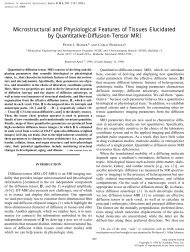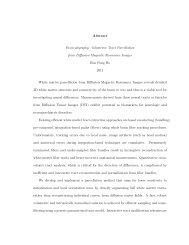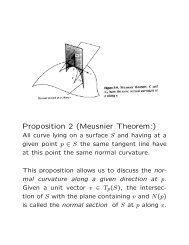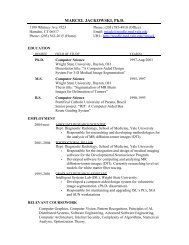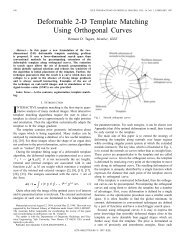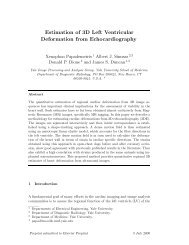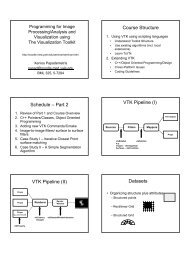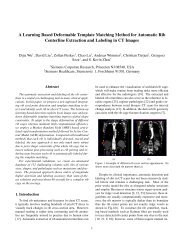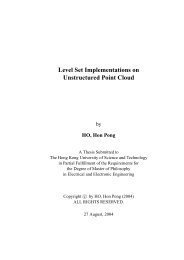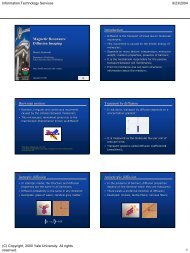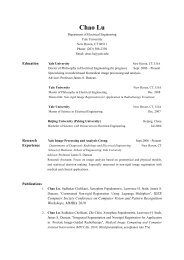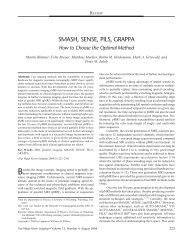Pulsed-field gradient nuclear magnetic resonance as a tool for ...
Pulsed-field gradient nuclear magnetic resonance as a tool for ...
Pulsed-field gradient nuclear magnetic resonance as a tool for ...
Create successful ePaper yourself
Turn your PDF publications into a flip-book with our unique Google optimized e-Paper software.
232<br />
PRICE<br />
move the couplings. Signal-to-noise problems with<br />
heteronuclei may also be alleviated by using inverse<br />
detection and the like Žsee<br />
Multiple Quantum<br />
and Hetero<strong>nuclear</strong> Experiments . .<br />
Often solvent suppression will be a problem,<br />
especially <strong>for</strong> low values of q, many possibilities<br />
exist <strong>for</strong> removing the solvent signal, especially<br />
those that can be placed be<strong>for</strong>e the PFG diffusion<br />
sequence. Examples include presaturation or<br />
water-PRESS Ž 113. and others Ž 114 . . As the value<br />
of q incre<strong>as</strong>es, the solvent signal is almost never a<br />
problem, since its intensity is reduced much f<strong>as</strong>ter<br />
than that of the Ž more slowly moving. species of<br />
interest by the PFG attenuation. This is, in fact,<br />
the b<strong>as</strong>is of another well-known method of water<br />
suppression, DRYCLEAN Ž 115 . .<br />
Typically, to obtain accurate diffusion coefficients<br />
of freely diffusing samples, it is desirable to<br />
record the echo attenuation over at le<strong>as</strong>t two<br />
orders of magnitude, although if the signal-tonoise<br />
ratio is very good, it is possible to determine<br />
the diffusion coefficient from a signal attenuation<br />
of only 1%. However, me<strong>as</strong>uring to high degrees<br />
of attenuation allows the effects of restricted<br />
diffusion, if present, to be visualized. It might<br />
seem advantageous to use absolute value Žalso<br />
referred to <strong>as</strong> power or magnitude. spectra to<br />
overcome eddy currentinduced ph<strong>as</strong>e instability<br />
and the like. This is true only in the c<strong>as</strong>e of<br />
first-order spectra or overlapped spectra Ž 4 . .Itis<br />
preferable to correct the data in ph<strong>as</strong>e-sensitive<br />
mode since, apart from the better spectral resolution,<br />
ph<strong>as</strong>e changes related to the <strong>gradient</strong> parameters<br />
are good indicators of eddy current effects<br />
and their absence provides some confidence<br />
that the data are artifact free.<br />
Because of the dependence of the attenuation,<br />
it is normally preferable to use high nuclei<br />
<strong>as</strong> the probe nuclei. To set cogent values <strong>for</strong> , ,<br />
and g in the experiment, it is worthwhile Ž<strong>as</strong>sum<br />
ing the simplest c<strong>as</strong>e of a monodisperse single<br />
species. to simulate the experiment using Eq.<br />
2 with an approximate value <strong>for</strong> the diffusion<br />
coefficient.<br />
A very obvious way to analyze the data, especially<br />
if a rough-and-ready analysis is acceptable,<br />
Ž . 2 2 2 is simply to plot ln E versus g Ž 3, .<br />
in which c<strong>as</strong>e the diffusion coefficient can be<br />
obtained from the slope Ž i.e., D . . However, this<br />
approach gives unequal weighting to the noise,<br />
particularly <strong>as</strong> the signal approaches zero. For<br />
this re<strong>as</strong>on, when higher accuracy is called <strong>for</strong>, it<br />
is better to use nonlinear regression of the relevant<br />
attenuation equation onto the experimental<br />
data. We note that von Meerwall and Ferguson<br />
wrote a specialized computer program <strong>for</strong> analyzing<br />
attenuation data with respect to a number of<br />
pertinent models Ž 116 . .<br />
CONCLUDING REMARKS<br />
This article does not claim to be exhaustive in its<br />
coverage of pulse sequences <strong>for</strong> me<strong>as</strong>uring diffusion<br />
and many other sequences exist e.g., Ž7,<br />
117 .,<br />
nor were special methods <strong>for</strong> me<strong>as</strong>uring<br />
diffusion in solids considered Ž 5 . . In p<strong>as</strong>sing, we<br />
note that in particular, the review by Stilbs Ž 4.<br />
also considered some experimental and technical<br />
<strong>as</strong>pects. In the present article, we have introduced<br />
some of the technical <strong>as</strong>pects related to<br />
per<strong>for</strong>ming PFG diffusion me<strong>as</strong>urements, and also<br />
to their analysis <strong>for</strong> simple systems. The single<br />
most important conclusion to draw from this article<br />
is that the reliability of the diffusion me<strong>as</strong>urements<br />
depends on the spectrometer and <strong>gradient</strong><br />
system being well characterized and calibrated.<br />
APPENDIX<br />
Maple Worksheet <strong>for</strong> the Stejskal and<br />
Tanner Equation, Including Gradient Pulses<br />
with Infinitely F<strong>as</strong>t Rise Times and Long<br />
Eddy Currents<br />
Reset the system<br />
> restart;<br />
Define the integral used in determining F<br />
> F(G, ti) int (G, t = ti..tf);<br />
Define the time intervals and the relevant value<br />
of g <strong>for</strong> each integral. Also calculate the value of<br />
F <strong>for</strong> each interval remembering that it contains<br />
the contribution from all of the intervals from the<br />
start of the pulse sequence.<br />
> l10;<br />
> g10;<br />
> F1F(g1, l1);<br />
> l2t1;<br />
> g2g;<br />
> F2subs (tf = l2, F1) + F(g2, l2);<br />
> l3t1 + delta;<br />
> g3g*exp(- k*(t- l3));<br />
> F3subs(tf = l3, F2) + F(g3, l3);



